Electrification
Electrification in Today’s Smart Cities
Electrification is super important for making our cities smart and sustainable! By switching to electric cars, smart power grids, and electric heating/cooling, cities can use less fossil fuels, lower GHG emissions, and make life healthier for everyone. Plus, when we use digital technologies with all this electric stuff, we enhance energy efficiency, the power grid works better, and we can use more renewable energy sources. All of this helps us build inclusive and sustainable cities, which is key to achieving the goals of the 2030 Agenda for Sustainable Development and the Paris Agreement climate targets. To reach our goal of net-zero emissions by 2050, we absolutely have to find alternatives to burning so many fossil fuels. Electrification is one of the main ways we can cut down on carbon, along with using renewable energy, being more energy-efficient, and using fuels that don’t emit as much CO2.
What is electrification?
Electrification is all about swapping out things that run on fossil fuels (like petrol and diesel cars or gas furnaces) for things that run on electricity (like electric cars or heat pumps). These electric versions are usually more energy efficient, which means we use less energy overall. Plus, as we switch to making electricity from renewable sources like solar and wind instead of coal and oil, running the electric appliances leads to even lower emissions!
For electrification to really work, it needs to do a few key things in parallel:
- Cut down on GHG emissions: The main goal is to reach net-zero emissions.
- Keep energy prices reasonable: It shouldn’t cost a fortune to power our lives or industries1Mekala Krishnan, Humayun Tai, Daniel Pacthod, Sven Smit, Tomas Nauclér, Blake Houghton, Jesse Noffsinger, and Dirk Simon, “An affordable, reliable, competitive path to net zero.” Mckinsey. 2023. https://www.mckinsey.com/capabilities/sustainability/our-insights/an-affordable-reliable-competitive-path-to-net-zero.
- Make sure the power stays on: We need a reliable supply of electricity for homes, businesses, and factories.
And it’s not just about cars! Electrification needs to happen everywhere – in transportation, how we heat and cool our homes and buildings, and in industries. We need to focus especially on the areas that pollute the most. See figure below.
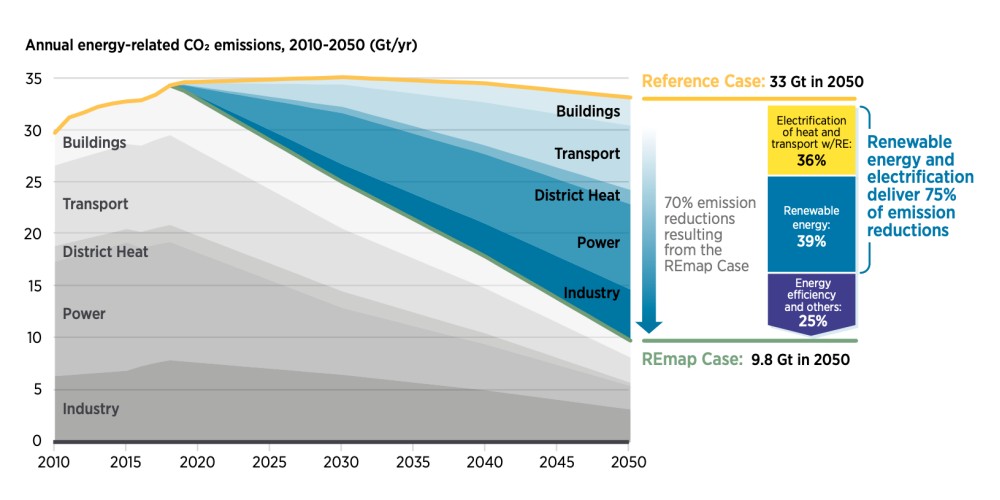 FIG. 1: How to reduce CO2 emission in key sectors by 2050
FIG. 1: How to reduce CO2 emission in key sectors by 2050
If we get really good at adopting renewable energy (like solar and wind) and combine that with smart digital technology, then electrification can totally change how we use energy. Instead of regular cars and trucks that run on petrol or diesel, we’d mostly use electric or fuel cell vehicles. And instead of heating our homes and buildings with oil or gas furnaces, we’d use heat pumps and electric boilers. Plus, we could even use electricity from renewable sources to make other types of fuel, like hydrogen, for things that are hard to power directly with electricity2IRENA, “Global energy transformation: The REmap transition pathway (Background report to 2019 edition)”. International Renewable Energy Agency, Abu Dhabi. 2019. https://www.irena.org/-/media/Files/IRENA/Agency/Publication/2019/Apr/IRENA_GET_REmap_pathway_2019.pdf.
Learn more about electrification by watching these videos:
FT short video on electrification: www.youtube.com/watch?v=wIpbK2Lg1sY
World Economic Forum on the Future of Energy: www.youtube.com/watch?v=VD6lMMfXDW0
The very comprehensive version of the electrification ‘story’ covering policy, financial, and technology challenges: www.youtube.com/watch?v=d4Cy16uOdLM
How do we increase renewables as part of the electrification process?
To achieve the full decarbonisation benefits of electrification, we need to focus on two closely interdependent elements. First, we have to switch from burning fossil fuels to renewable energy as quickly as possible. That’s how we’ll reach our goal of ‘net zero’ emissions. Second, since everyone will be using more electricity, our power grids need to get bigger and way more flexible to handle all the changes3International Energy Agency, “Electrification”. No date. https://www.iea.org/energy-system/electricity/electrification.
Increasing the percentage of renewable energy into the system means we’ll be using a lot of ‘variable’ energy sources, like solar and wind. ‘Variable’ means they are not providing a stable amount of energy to the system as the sun doesn’t always shine, and the wind doesn’t always blow. To make this work, we’ll need new technology, upgrades to the power infrastructure, and updated government rules and support. Everyone has to be on board for this to function optimally!
As we can see from the figure below, renewables come from various sources and are location-specific, i.e., some countries have access to significant sources of wind energy while others are more suited for solar.
 FIG. 2: Average cost of VRE and displaced fossil fuel generation (LCOE approach), total VRE generation, 2015-20284 International Energy Agency, “World Energy Outlook.” 2023. https://www.iea.org/reports/world-energy-outlook-2023
FIG. 2: Average cost of VRE and displaced fossil fuel generation (LCOE approach), total VRE generation, 2015-20284 International Energy Agency, “World Energy Outlook.” 2023. https://www.iea.org/reports/world-energy-outlook-2023
No matter what kind of renewable energy a place uses (like lots of sun or lots of wind), it’s super important that the power grids get ‘smart’ when we use more of that renewable energy. What does ‘smart’ mean? It means using technology that can talk to each other and control things! This tech helps us plug in renewable energy sources easily, waste less electricity as it travels, and react quickly when energy demand changes. Basically, all these things help us make sure our future electricity grid continues to be as efficient, reliable, and sustainable as possible.
Let’s look at an example: Electric Vehicles (EVs)
Okay, let’s talk about electric cars! They’re a really big part of electrification. Basically, way more people are buying electric cars now. In just one year, from 2022 to 2023, sales jumped up by about 35% worldwide. And things are going to keep growing – experts think the total number of electric cars on the road will be NINE TIMES bigger in 2030 than it was in 2022 (from 27 million units in 2022 to 230 million units in 2030). That’s a huge increase! So, EVs are definitely becoming a much bigger deal as we move away from cars that run on petrol and diesel.
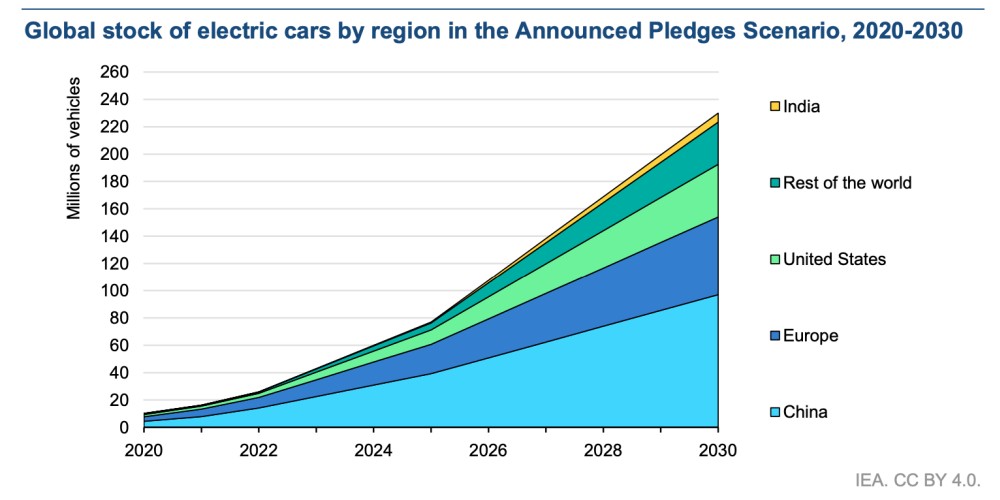 FIG. 3: Current and predicted numbers of electric vehicles by region5International Energy Agency, “Global EV Data Explorer.” July, 2025. https://www.iea.org/data-and-statistics/data-tools/global-ev-data-explorer
FIG. 3: Current and predicted numbers of electric vehicles by region5International Energy Agency, “Global EV Data Explorer.” July, 2025. https://www.iea.org/data-and-statistics/data-tools/global-ev-data-explorer
How and why do we need to electrify? Using the electric vehicles as an example:
Want to learn more about the electrification of transport? Take this online course: www.futurelearn.com/courses/electrification-of-urban-mobility/1
Oslo example of electrification (transport): www.youtube.com/watch?v=IdawuX8PGl0 | www.youtube.com/watch?v=VhhvLIeb8ZY
How does the electricity infrastructure need to change to be Fit-for-purpose
Now let’s talk about another super important part of electrification: our power grids. Basically, as we use more electricity, our power grids need to expand their capacity and flexibility. Why? Two main reasons:
- We’ll need more electricity: More people are using electric cars, electric heating, and so on, so the demand for electricity will go WAY up.
- Renewable energy isn’t always steady: Sources like solar and wind vary a lot. Sometimes there’s tons of energy, and sometimes there’s barely any. So the grid has to be able to handle these ups and downs.
We can already see this happening in places like Norway, where lots of people have electric cars. To keep everything running smoothly and cleanly, they need to add a lot more renewable energy to the mix really fast to ensure the electrification results in decarbonisation.
In fact, experts think that by 2050, more than HALF of all the energy we use will be electricity! That’s up from just 20% in 2023. So our power grids need a BIG makeover to keep up6International Energy Agency, “Empowering Urban Energy Transitions, Smart Cities and Smart Grids.” 2024. https://www.iea.org/reports/empowering-urban-energy-transitions.
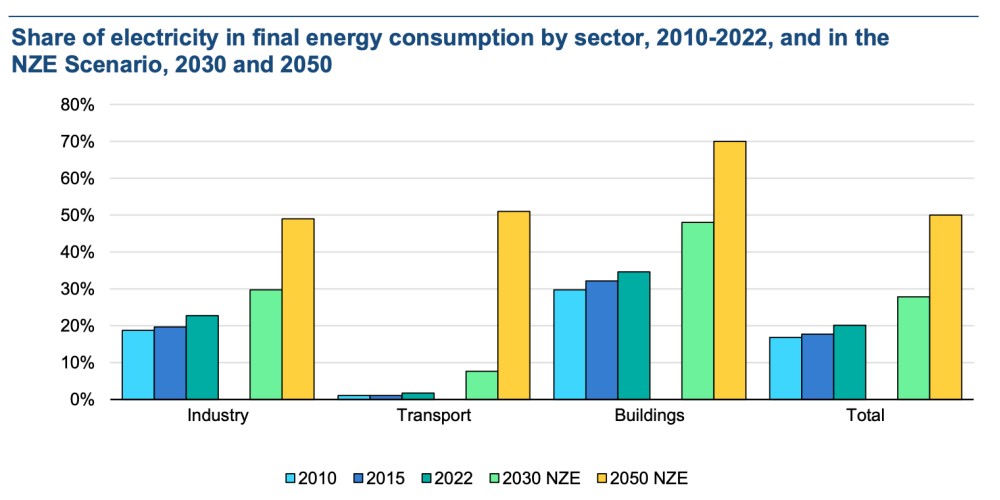 FIG. 4: Net Zero Emissions predictions for electricity use by sector7International Energy Agency, “Net Zero Roadmap: A Global Pathway to Keep the 1.5°C in Reach.” 2023. https://www.iea.org/reports/net-zero-roadmap-a-global-pathway-to-keep-the-15-0c-goal-in-reach
FIG. 4: Net Zero Emissions predictions for electricity use by sector7International Energy Agency, “Net Zero Roadmap: A Global Pathway to Keep the 1.5°C in Reach.” 2023. https://www.iea.org/reports/net-zero-roadmap-a-global-pathway-to-keep-the-15-0c-goal-in-reach
Since we’re going to be using WAY more electricity, increasingly coming from intermittent sources, our power grids need a big upgrade8International Energy Agency, 2024! Think of it like this: our old roads were built for a few cars, but now we need superhighways.
We need to:
- Fix up the old infrastructure: Upgrade the power grid infrastructure we already have so it can handle more electricity and be more flexible.
- Build new infrastructure: Where existing infrastructure is insufficient, we need to put up new power lines, especially to connect new renewable energy plants to the places where people actually need the electricity (like cities).
All this work is super important so countries can switch to clean energy in a way that’s fair for everyone and doesn’t cost too much. Basically, our power grids need to be ready for the future!
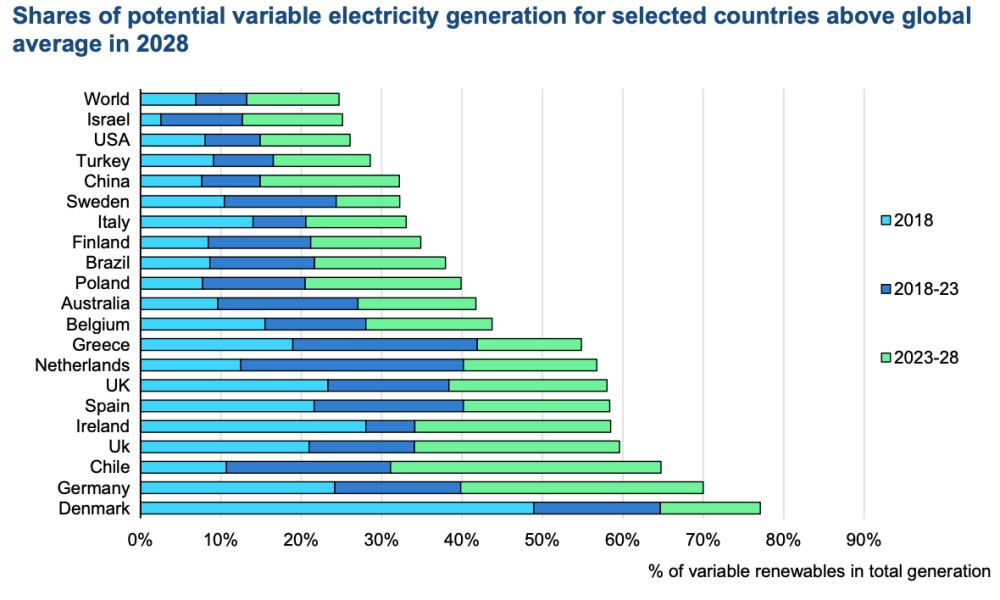 FIG. 5: Past, current and predicted percentages of variable renewables in the total generation of electricity, for the world and some countries specifically9International Energy Agency, “Renewables 2023. Analysis and forecast to 2028.”, 2023, https://www.iea.org/reports/renewables-2023
FIG. 5: Past, current and predicted percentages of variable renewables in the total generation of electricity, for the world and some countries specifically9International Energy Agency, “Renewables 2023. Analysis and forecast to 2028.”, 2023, https://www.iea.org/reports/renewables-2023
How will this impact cities?
Cities are going to have a LOT of challenges with all this electrification stuff. Why? Because cities are crowded, right? Lots of people live close together in apartments and houses. That means everyone wants to use electricity at the same time – to heat or cool their homes, charge their electric cars, and power everything else!
This can lead to grid congestion, like traffic jams for electricity. And it gets even more complicated when people have solar panels on their own roofs, feeding electricity back into the grid.
To make cities work in this electric future, city planners, government leaders, and the companies that run the power grids all need to work together. They need to plan everything out so that our cities have enough power and the power system is reliable. Basically, city planning and electricity planning have to go hand in hand now10International Energy Agency, 2024.
Watch this video that explores why “Just building green generation is not sufficient – the green generation needs to reach the cities and they are sometimes far apart”:
Challenges with electrification: Critical minerals
So, we want lots of electric things and lots of renewable energy, right? Well, that means we need a bunch of special materials called critical minerals. Think of them like the ingredients you need to bake a cake. You can’t make the cake without flour and eggs. In this case, we can’t make batteries, solar panels, and wind turbines without things like lithium, copper, and other rare metals.
Here’s the deal:
- We need lots of these minerals: As we build more electric cars and solar panels, the demand for these minerals is going way up. Experts say the need for lithium might increase 5 to 7 times by 203011International Energy Agency, “Batteries and Secure Energy Transitions, World Energy Outlook Special Report.” 2023. https://www.iea.org/reports/batteries-and-secure-energy-transitions!
- Getting these minerals can be tricky: They aren’t found everywhere, and digging them up can sometimes harm the environment or cause problems for the people who live near the mines.
- These minerals are very important: Copper is needed for electric wires, lithium is needed for batteries12International Energy Agency, “World Energy Outlook.” 2023. https://www.iea.org/reports/world-energy-outlook-2023, and other special metals help make wind turbines work. Without them, we can’t really make this whole electrification thing happen.
So, we need to find ways to get these minerals responsibly, without hurting the planet or people, because they’re a crucial part of the clean energy future.
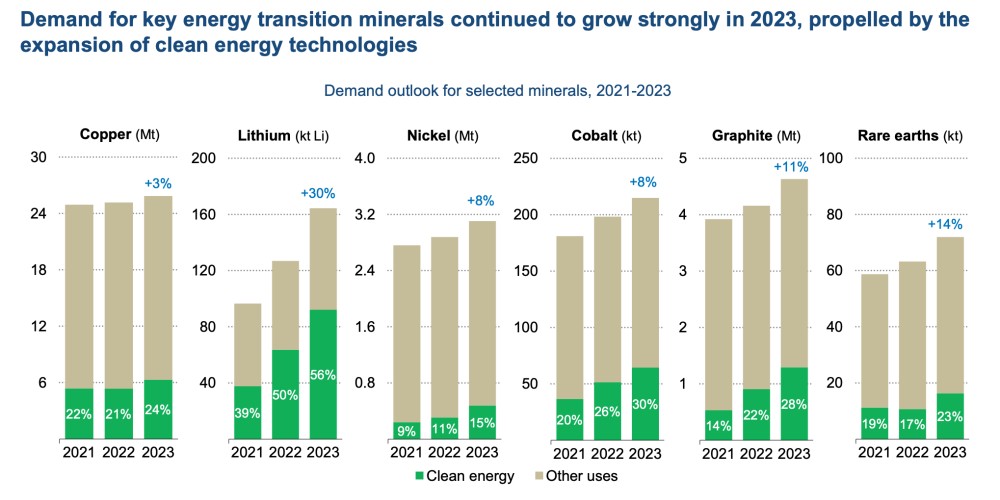 FIG. 6: Demand for transition minerals 2021, 2022, 202313IEA, “Global Critical Minerals Outlook”, 2024, https://iea.blob.core.windows.net/assets/ee01701d-1d5c-4ba8-9df6-abeeac9de99a/GlobalCriticalMineralsOutlook2024.pdf
FIG. 6: Demand for transition minerals 2021, 2022, 202313IEA, “Global Critical Minerals Outlook”, 2024, https://iea.blob.core.windows.net/assets/ee01701d-1d5c-4ba8-9df6-abeeac9de99a/GlobalCriticalMineralsOutlook2024.pdf
Watch this video to understand the True Cost of Lithium Mining:
FT longer version:
CASE EXAMPLE: L.A.
The city of Los Angeles (LA) made a big decision. They said they want to make their city run on 100% renewable energy by 2035! That means they want to stop using fossil fuels in all public institutions and activities or services, like government buildings and vehicles.
But they quickly realised they can’t just switch to renewable energy. They ALSO have to upgrade their power grid. Why? Because all that new electricity from solar and wind needs a bigger, better power grid to get to everyone. They basically said: ‘We need to do both things at the same time: 1. switch to clean energy AND 2. build a better power grid.’ And they’re totally right! You can’t have one without the other.
Watch this video to learn more about the strategy adopted by Los Angeles:
Bibliography
- International Energy Agency, “World Energy Outlook.” 2023. https://www.iea.org/reports/world-energy-outlook-2023
- International Energy Agency, “Empowering Urban Energy Transitions, Smart Cities and Smart Grids.” 2024. https://www.iea.org/reports/empowering-urban-energy-transitions
- International Energy Agency, “Electrification”. No date. https://www.iea.org/energy-system/electricity/electrification
- International Energy Agency, “Net Zero by 2050. A Roadmap for the Global Energy Sector.” 2021. https://www.iea.org/reports/net-zero-by-2050
- International Energy Agency, “Renewables 2023. Analysis and forecast to 2028.” 2023 https://www.iea.org/reports/renewables-2023
- International Energy Agency, “Global EV Data Explorer.” July, 2025. https://www.iea.org/data-and-statistics/data-tools/global-ev-data-explorer
- International Energy Agency, “Global Critical Minerals Outlook”, 2024, https://iea.blob.core.windows.net/assets/ee01701d-1d5c-4ba8-9df6-abeeac9de99a/GlobalCriticalMineralsOutlook2024.pdf
- International Energy Agency, “Net Zero Roadmap: A Global Pathway to Keep the 1.5°C in Reach.” 2023. https://www.iea.org/reports/net-zero-roadmap-a-global-pathway-to-keep-the-15-0c-goal-in-reach
- International Energy Agency, “Batteries and Secure Energy Transitions, World Energy Outlook Special Report.” 2023. https://www.iea.org/reports/batteries-and-secure-energy-transitions
- IRENA, “Global energy transformation: The REmap transition pathway (Background report to 2019 edition)”. International Renewable Energy Agency, Abu Dhabi. 2019. https://www.irena.org/-/media/Files/IRENA/Agency/Publication/2019/Apr/IRENA_GET_REmap_pathway_2019.pdf
- Krishnan, Mekala, Humayun Tai, Daniel Pacthod, Sven Smit, Tomas Nauclér, Blake Houghton, Jesse Noffsinger, and Dirk Simon, “An affordable, reliable, competitive path to net zero.” Mckinsey. 2023. https://www.mckinsey.com/capabilities/sustainability/our-insights/an-affordable-reliable-competitive-path-to-net-zero
These articles have been reviewed using AI in order to align the style and length of each article. The research and content are original to the authors noted.

